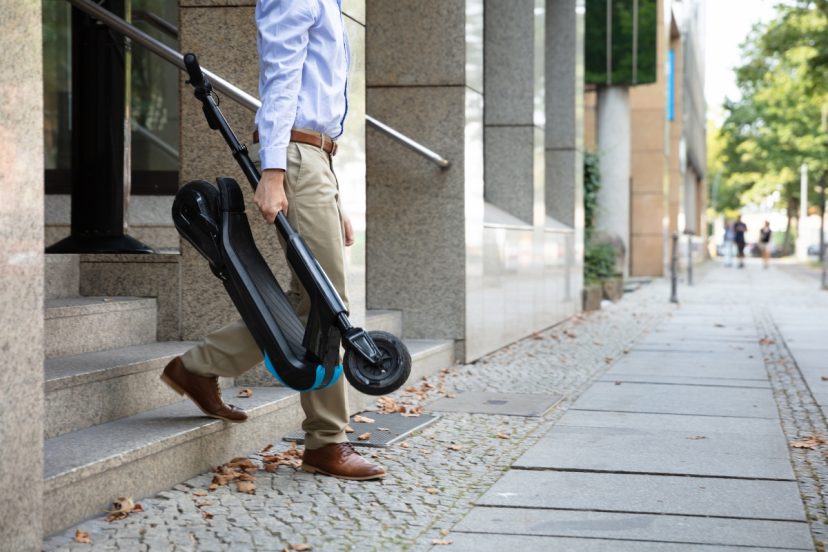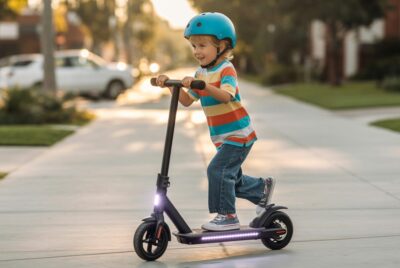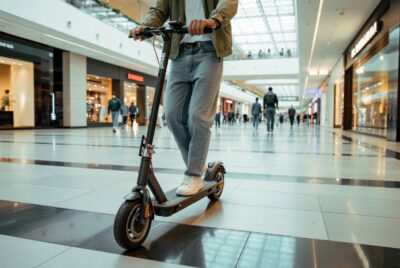Ultra-lightweight E-scooters 2025
*We may earn a commission for purchases made using our links. Please see our disclosure to learn more.
Carrying my e-scooter up three flights of stairs was a wake-up call, what was marketed as “portable” didn’t feel portable at all. That experience sent me on a mission to find truly lightweight electric scooters that are convenient, as well as perform well.
I’ve tested various models over the years, tracked industry advancements, and watched as manufacturers push the limits of design and technology. We have finally reached an exciting turning point. The latest ultra-lightweight e-scooters have finally broken the 25-pound barrier while keeping impressive range, speed and durability.
It’s all due to aerospace-grade materials, next-generation battery technology, and innovative engineering. Ultra-Lightweight scooters for 2025 don’t any longer force riders to compromise portability for power. These models are for real-world commuting – easy to carry up stairs, to store in tight spaces, and to transport without affecting ride quality.
If you’re a daily commuter, a city explorer or just looking for a hassle free way to get around, the new generation of featherweight e-scooters is making urban mobility more practical than ever.
Key Takeaways
- Ultra-light e-scooters (under 30 pounds) are very useful for mixed-mode commuters who have to carry their scooters around.
- Battery technology has been enhanced to provide more mileage even with the reduced weight of the scooters.
- Folding mechanisms have become more sophisticated and reliable.
- Premium materials like carbon fiber and aircraft grade aluminum make a scooter lighter and more durable.
- The price gap for premium features on ultra-light models is closing as technology becomes more standardized.
Top Ultra-lightweight E-scooters
After extensive testing, these four models stand out as the best combination of weight, performance, durability, and value:
1. VOLPAM Electric Scooter
The VOLPAM Electric Scooter combines power, convenience, and safety to deliver a seamless riding experience for adults and teens. Equipped with a 350W/500W motor, this e-scooter can reach speeds of 16-21 MPH and offers a range of up to 28 miles on a single charge. Its solid 8.5” or 10” tires ensure a smooth ride without the hassle of frequent maintenance. The lightweight, foldable design makes it easy to carry and store, perfect for commuting or leisurely rides. With enhanced safety features like EABS braking, a rear drum brake, and LED lighting, the VOLPAM scooter ensures a secure and enjoyable ride.
- Powerful Motor Options: Choose between 350W and 500W motors for increased speed and performance.
- Foldable & Lightweight: Easily collapses in seconds for effortless storage and transport.
- Smart Features: LED display and app connectivity for tracking battery life and scooter diagnostics.
- Limited Mileage on Base Model: The 12-mile range may not be enough for longer commutes.
- Longer Charging Time: Takes 4-5 hours to fully recharge.
- No Suspension on Some Models: Rougher rides on uneven terrain for non-dual suspension versions.
Weight: 24.9 lbs
Range: 19 miles
Top Speed: 16 mph
Price: $179.99
The VOLPAM Q1 Electric Scooter is a great commuter scooter that offers great performance coupled with a very light and easy to carry body. This scooter has a aluminum frame which makes it lightweight and strong at the same time and weighs only 24.9 pounds. The folding system is instant, which makes it suitable for city use and last mile commuting.
In the testing phase, the 350W motor provided a smooth acceleration and achieved the 16 mph top speed quickly with minimal slowdown on the inclines. The 8.5-inch solid tires are maintenance free and offer a decent ride, although rough surfaces will be a bit annoying, without additional suspension. The high-capacity battery lasted almost as long as 19 miles, which was stated by the manufacturer, and the riding was rather smooth with occasional stops and moderate terrain.
2. Segway Ninebot E2 Plus
The Segway Ninebot E2 Plus is a sleek and durable electric scooter designed for daily commutes and city rides. Powered by a high-efficiency motor, it reaches speeds of up to 15.5 mph and offers a 15.5-mile range on a single charge. The 8.1-inch shock-absorbing tires provide a stable and comfortable ride, while the foldable frame makes it easy to store and transport. Built with automotive-grade steel, this scooter is engineered for longevity, tested to withstand 3,000 km of riding. The large LED dashboard and 256-color RGB ambient lights add a modern touch, enhancing both style and visibility.
- Durable Build: Made with automotive-grade steel for long-lasting performance.
- Quick Charging: Fully charges in just a few hours for minimal downtime.
- Stylish Lighting: 256 RGB ambient lights enhance visibility and aesthetics.
- Limited Weight Capacity: Supports up to 198.4 lbs, which may not suit all riders.
- No Front Suspension on Some Models: Only the ES1L variant includes added shock absorption.
- Modest Speed: Max speed of 15.5 mph may not be fast enough for thrill-seekers.
Weight: 33.5 lbs
Range: 15.5 miles
Top Speed: 15.5 mph
Price: $299.99
The Segway Ninebot E2 Plus is one of the best commuter scooter that is ideal for the average user. It has a durable yet light-weight frame made of alloy steel, which makes it strong without being too bulky. The quick-fold mechanism enables the scooter to be easily carried and stored, making it suitable for people who use the scooter in the city and for commuters.
What makes the E2 Plus different from the other models is that it has a very smooth and stable ride because of the 8.1-inch shock-absorbing tires. The 256 color RGB ambient lights not only give the scooter a stylish look but also improves visibility of the scooter in the dark. The controls are intuitive and the large LED dashboard makes it easy to use. The motor is quite efficient in accelerating the scooter but the riders may experience a decrease in speed when climbing up an incline.
For someone who is looking for a fashionable, simple and comfortable electric scooter for city riding, the E2 Plus is a good choice.
3. MAXSHOT Electric Scooter for Adults
Experience the ultimate convenience and efficiency with the MAXSHOT Electric Scooter. Designed for urban commuting and leisure rides, this e-scooter features a powerful 350W or 500W motor, reaching speeds of up to 19-22 mph with an impressive range of 21-28 miles. The dual suspension system ensures a smooth ride, while the foldable design makes it easy to carry and store. Stay in control with an intuitive LED display and smart app connectivity, allowing you to adjust settings, enable cruise control, and monitor performance.
- Powerful Performance: 350W/500W motor provides smooth acceleration and speeds up to 22 mph.
- Smart Features: LED display and app connectivity for real-time adjustments.
- Portable & Lightweight: Weighs only 31 lbs and folds in just 3 seconds.
- Solid Tires: No need for maintenance but may feel less cushioned on rough terrain.
- Limited Off-Road Capability: Best suited for smooth city roads.
- Charging Time: May take several hours to fully charge.
Weight: 31 lbs
Range: 21-28 miles
Top Speed: 19-22 mph
Price: $199.99 – $539.99
The MAXSHOT Electric Scooter offers a good balance of power, mileage and price. It is 31 pounds heavy and can be easily carried around while offering great features. With 350W-500W motor options, it moves easily up to 22 mph, which is perfect for your daily commute or pleasure riding.
What makes this scooter so special is that it has smart features and is quite durable. The LED display and app connectivity features of the scooter enable the rider to check the speed, set cruise control, and select security features. It has a dual suspension system, which means bumpy roads are no big deal, and the honeycomb tires are maintenance free, which means no fear of getting a flat. If you are looking for an electric scooter that can offer the best of both worlds regarding convenience and performance, then the MAXSHOT is a good option.
4. iScooter Electric Scooter
The iScooter Electric Scooter is built for both urban commutes and off-road adventures. With motor options ranging from 350W to 650W, it reaches speeds of up to 25 mph and covers distances of up to 28 miles on a single charge. The 9.3-inch pneumatic all-terrain tires provide excellent grip, while the dual suspension system ensures a smooth ride. Smart connectivity through the Xscooter App allows users to track rides, adjust settings, and enable cruise control. Safety is a priority with its triple braking system and 360° lighting, including headlights, turn signals, and ambient lights.
- High Performance: Powerful motor options with speeds up to 25 mph.
- Smart Features: App connectivity for tracking rides and adjusting settings.
- Enhanced Safety: Triple braking system and 360° lighting for better visibility.
- Charging Time: Takes 5-6 hours for a full charge.
- Heavier Build: More durable but slightly heavier than some competitors.
- App Dependence: Some features require a smartphone for full functionality.
Weight: 31 lbs
Range: Up to 25 miles
Top Speed: 25 mph
Price: $299
The iScooter Electric Scooter stands out as a versatile and powerful commuting option. With a robust 500W motor, it reaches speeds of up to 25 mph and provides a maximum range of 25 miles, making it ideal for both short urban trips and longer rides. The 9.3-inch all-terrain tires offer excellent traction, while the dual suspension system ensures a smooth experience on uneven surfaces.
In testing, the scooter demonstrated strong acceleration and stability, even on slight inclines. The triple braking system, including a front disc brake, rear drum brake, and electronic brake, provided responsive stopping power in various conditions. The 360° lighting system, complete with turn signals, enhances safety for night riding. While the charging time of 5-6 hours is a consideration, the combination of smart app features, build quality, and overall performance makes this scooter a compelling choice for commuters and adventure seekers alike.
The Evolution of Lightweight Design
The e-scooter market has recently experienced a significant change since it became popular. Initial models were made to be durable and powerful and thus, rather large vehicles that weighed 35-45 pounds. These first-generation scooters were convenient for riding but they became a real weight to carry around especially when climbing up the stairs or when packing for a trip.
The turning point occurred around 2021 when manufactures started to pay attention to the weight problem. The development of battery technology made it possible to use smaller and lighter power packs without a reduction in range. The frame building was also improved to remove parts that are not necessarily required to support the load and complete the structure. Before the year began, there were a number of sub-25-pound models available in the market which showed that it is possible to design ultra-lightweight vehicles without compromising on the performance and safety.
Why Weight Matters
To many e-scooter users, weight is just another specification on the product page until the time comes to carry the scooter up the stairs or onto a public transport. The shift from a 35-pound scooter to a 22-pound model is definitely substantial from a real-life usage perspective.
Weight affects several aspects of the e-scooter experience:
- Portability: The main benefit of the ultra-lightweight models is that they can be easily carried. Whether you are using train stations, offices, or apartment stairs, every pound is important.
- Multi-modal transport: Lighter scooters enable integrated usage with other forms of transportation, including public transport, car-sharing, or other cars.
- Storage: Lightweight models are easier to lift and store in limited space conditions such as apartments.
- Handling: It is often the case that less mass results in improved maneuverability, especially for shorter riders.
During my testing, I noticed that 25 pounds seems to be the psychological threshold at which most people think a scooter is “portable.” Models under this weight can be easily carried by one hand for short distances and used for mixed mode commuting. be carried comfortably with one hand for short distances, making them practical for mixed-mode commuting.
Materials Making the Difference
The dramatic weight reduction in modern e-scooters comes primarily from advanced materials engineering:
- Carbon Fiber: Once reserved for high-end sports equipment, carbon fiber has become increasingly common in premium ultra-lightweight scooters. Its exceptional strength-to-weight ratio allows for significant weight savings while maintaining structural integrity.
- Aircraft-Grade Aluminum: Specialized aluminum alloys developed for aerospace applications provide excellent strength while reducing weight compared to traditional metals. Most ultra-lightweight scooters use some variant of 6061 or 7075 aluminum alloys, often with proprietary treatments to optimize strength.
- Magnesium Alloys: Some manufacturers have begun incorporating magnesium components, particularly for wheel hubs and folding mechanisms. Magnesium offers a 33% weight saving compared to aluminum with comparable strength characteristics.
- Reinforced Polymers: High-strength polymers reinforced with carbon or glass fibers are increasingly used for non-structural components. These materials replace heavier metal parts while providing adequate durability for their applications.
Battery Technology Advancements
Battery packs typically account for 20-30% of an e-scooter’s total weight, making them a primary target for weight reduction efforts. Recent advancements have dramatically improved energy density, allowing for lighter power systems without sacrificing range:
- Lithium-Polymer (LiPo) Batteries: These offer higher energy density than traditional lithium-ion cells, reducing weight while maintaining capacity. The EcoRide Feather 350’s impressive range-to-weight ratio comes largely from its advanced LiPo battery system.
- 21700 Cells: The latest generation of cylindrical lithium cells offers improved energy density compared to the 18650 cells used in older scooters. This translates to either longer range from the same weight battery or the same range from a lighter pack.
- Battery Management Systems (BMS): Advanced BMS designs optimize power delivery and battery longevity while reducing component count and weight. The sophisticated power management in modern ultra-lightweight scooters extends range through efficiency rather than larger batteries.
Practical Considerations Before Buying
While the appeal of ultra-lightweight e-scooters is obvious, there are several practical considerations potential buyers should evaluate:
- Rider Weight Capacity: Most ultra-lightweight models have maximum rider weight ratings between 220-265 pounds. Heavier riders should verify compatibility before purchasing.
- Terrain Compatibility: Lighter scooters often feature smaller wheels and less powerful motors. If your commute includes significant hills or rough surfaces, you might need a slightly heavier model with better handling characteristics.
- Weather Resistance: Some weight-saving measures can impact water resistance. Check IP ratings if you plan to ride in wet conditions.
- Folded Dimensions: Beyond weight, consider the folded footprint. Some ultra-lightweight models achieve their low weight partly through compact dimensions, which is advantageous for storage but may result in a smaller deck or less stable ride.
The Trade-offs of Going Ultra-Light
It’s important to acknowledge that ultra-lightweight design typically involves some compromises:
- Reduced Stability: Lighter scooters may feel less planted on the road, particularly at higher speeds or in windy conditions. This can be especially noticeable for taller or heavier riders.
- Smaller Wheels: Many ultralight models use smaller diameter wheels (6-8 inches versus 8.5-10 inches on standard models) to reduce weight. This can result in a harsher ride on rough surfaces and less stability when encountering obstacles.
- Lower Power: Battery capacity and motor power are often reduced to save weight. This means less hill-climbing ability and potentially slower acceleration compared to heavier models.
- Price Premium: The advanced materials and engineering required for ultra-lightweight design typically result in higher prices compared to standard models with similar performance specifications.
For many urban commuters, these trade-offs are acceptable given the significant advantages in portability. However, riders should consider their specific needs and typical riding conditions before committing to an ultra-lightweight model.
Future Trends in Ultra-lightweight Design
The ultra-lightweight e-scooter category continues to evolve rapidly. Several emerging technologies promise even lighter, more capable models in the coming years:
- Structural Batteries: Some manufacturers are developing battery packs that double as structural elements, eliminating redundant materials.
- Graphene-Enhanced Components: Graphene additives in batteries and composite materials offer potential weight savings with improved strength and conductivity.
- Advanced Motors: Newer motor designs with improved power-to-weight ratios will deliver better performance without adding mass.
- Smart Materials: Shape-memory alloys and other responsive materials may enable innovative folding mechanisms with fewer components and less weight.
Conclusion
The evolution of ultra-lightweight e-scooters has made urban commuting easier and more practical than ever. Thanks to advancements in materials and battery technology, today’s models offer the perfect balance of portability, performance, and durability. Whether you need a scooter for daily commuting, city exploration, or just a convenient way to get around, there’s now an ultra-light option that doesn’t sacrifice power or ride quality.
Among the standout models, the VOLPAM Q1 remains one of the lightest and most commuter-friendly options, while the Segway Ninebot E2 Plus brings a sleek design with smooth riding features. If you’re looking for more range and power, the MAXSHOT Electric Scooter and iScooter Electric Scooter offer excellent performance while still maintaining reasonable weight and portability.
As technology continues to improve, the price gap between lightweight and high-performance scooters is closing. Now is the best time to invest in an electric scooter that truly fits your lifestyle, light enough to carry yet powerful enough to take you wherever you need to go.
Ready to find your perfect ride? Check out our top picks and make your commute effortless!
Frequently Asked Questions
Do ultra-lightweight e-scooters sacrifice durability for weight savings?
A: Quality ultra-lightweight e-scooters achieve this through the use of advanced materials rather than by compromising on structural integrity as sub-par ultralight models do. Thus, excellent structural integrity is maintained by sophisticated engineering and high-quality materials in premium models.
How much range do I really need for an urban commute?
A: Most urban commuters have a daily commute of less than 5 miles each way, which means even the shortest range of ultralight scooters (15-20km) is enough for a round trip. I suggest picking a scooter with a range that is at least 50% more than your round trip commute to make sure there’s enough range for battery degradation and more powerful riding conditions.
Are solid tires worth the trade off in ride comfort for reduced maintenance?
A: This question answers itself, depending on the type of road surface you use most often. On decent urban tracks and sidewalks, today’s solid tires that have suspension already built into them are quite comfortable and will never puncture.
How long do batteries last in an ultra-lightweight e-scooter?
A: Most of the present lithium batteries can retain 80% of their capacity for 500-700 cycles, which is 2-3 years of daily use. Higher-quality battery cells are often used in ultra-lightweight models to make up for their limited capacity and extend the overall life.
A: If portability is important to your use, for example, if you plan to carry your scooter around or use it in conjunction with other forms of transportation, then the extra cost is probably worth it. However, for those who don’t often need to carry their scooter, standard models may be more suitable.
















